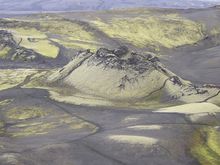Volcano

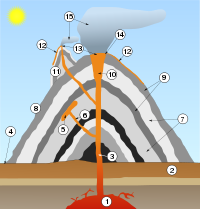
| Cross-section through a stratovolcano (vertical scale is exaggerated): | |
|---|---|
| 1. Large magma chamber 2. Bedrock 3. Conduit (pipe) 4. Base 5. Sill 6. Dike 7. Layers of ash emitted by the volcano 8. Flank |
9. Layers of lava emitted by the volcano 10. Throat 11. Parasitic cone 12. Lava flow 13. Vent 14. Crater 15. Ash cloud |

A volcano is an opening, or rupture, in a planet's surface or crust, which allows hot magma, ash and gases to escape from below the surface. The word volcano is derived from Vulcano, the name of an island off Sicily which in turn was named after Vulcan, the Roman god of fire.[1]
Volcanoes are generally found where tectonic plates are diverging or converging. A mid-oceanic ridge, for example the Mid-Atlantic Ridge, has examples of volcanoes caused by divergent tectonic plates pulling apart; the Pacific Ring of Fire has examples of volcanoes caused by convergent tectonic plates coming together. By contrast, volcanoes are usually not created where two tectonic plates slide past one another. Volcanoes can also form where there is stretching and thinning of the Earth's crust (called "non-hotspot intraplate volcanism"), such as in the East African Rift, the Wells Gray-Clearwater volcanic field and the Rio Grande Rift in North America.
Volcanoes can be caused by mantle plumes. These so-called hotspots, for example at Hawaii, can occur far from plate boundaries. Hotspot volcanoes are also found elsewhere in the solar system, especially on rocky planets and moons.
Contents |
Etymology
The word volcano is derived from the name of Vulcano, a volcanic island in the Aeolian Islands of Italy whose name in turn originates from Vulcan, the name of a god of fire in Roman mythology. The study of volcanoes is called volcanology, sometimes spelled vulcanology.
Plate tectonics and hotspots

Divergent plate boundaries
At the mid-oceanic ridges, two tectonic plates diverge from one another. New oceanic crust is being formed by hot molten rock slowly cooling and solidifying. The crust is very thin at mid-oceanic ridges due to the pull of the tectonic plates. The release of pressure due to the thinning of the crust leads to adiabatic expansion, and the partial melting of the mantle causing volcanism and creating new oceanic crust. Most divergent plate boundaries are at the bottom of the oceans, therefore most volcanic activity is submarine, forming new seafloor. Black smokers or deep sea vents are an example of this kind of volcanic activity. Where the mid-oceanic ridge is above sea-level, volcanic islands are formed, for example, Iceland.
Convergent plate boundaries
Subduction zones are places where two plates, usually an oceanic plate and a continental plate, collide. In this case, the oceanic plate subducts, or submerges under the continental plate forming a deep ocean trench just offshore. Water released from the subducting plate lowers the melting temperature of the overlying mantle wedge, creating magma. This magma tends to be very viscous due to its high silica content, so often does not reach the surface and cools at depth. When it does reach the surface, a volcano is formed. Typical examples for this kind of volcano are Mount Etna and the volcanoes in the Pacific Ring of Fire.

Hotspots
Hotspots are not usually located on the ridges of tectonic plates, but above mantle plumes, where the convection of the Earth's mantle creates a column of hot material that rises until it reaches the crust, which tends to be thinner than in other areas of the Earth. The temperature of the plume causes the crust to melt and form pipes, which can vent magma. Because the tectonic plates move whereas the mantle plume remains in the same place, each volcano becomes dormant after a while and a new volcano is then formed as the plate shifts over the hotspot. The Hawaiian Islands are thought to be formed in such a manner, as well as the Snake River Plain, with the Yellowstone Caldera being the part of the North American plate currently above the hot spot.
Volcanic features

The most common perception of a volcano is of a conical mountain, spewing lava and poisonous gases from a crater at its summit. This describes just one of many types of volcano, and the features of volcanoes are much more complicated. The structure and behavior of volcanoes depends on a number of factors. Some volcanoes have rugged peaks formed by lava domes rather than a summit crater, whereas others present landscape features such as massive plateaus. Vents that issue volcanic material (lava, which is what magma is called once it has escaped to the surface, and ash) and gases (mainly steam and magmatic gases) can be located anywhere on the landform. Many of these vents give rise to smaller cones such as Puʻu ʻŌʻō on a flank of Hawaii's Kīlauea.

Skjaldbreiður, a shield volcano whose name means "broad shield"

January 2009 image of the rhyolitic lava dome of Chaitén Volcano, southern Chile during its 2008-2009 eruption
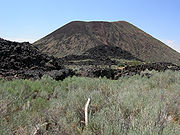
Holocene cinder cone volcano on State Highway 18 near Veyo, Utah
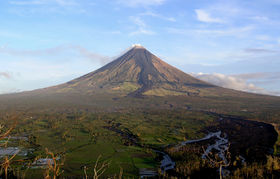
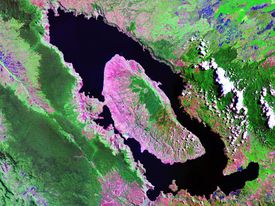
The Lake Toba volcano created a caldera 100 km long.
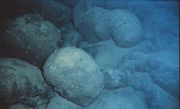
Pillow lava (NOAA)

Herðubreið, one of the tuyas in Iceland
Mud volcano on Taman Peninsula, Russia
|
Other types of volcano include cryovolcanoes (or ice volcanoes), particularly on some moons of Jupiter, Saturn and Neptune; and mud volcanoes, which are formations often not associated with known magmatic activity. Active mud volcanoes tend to involve temperatures much lower than those of igneous volcanoes, except when a mud volcano is actually a vent of an igneous volcano.
Fissure vents
Volcanic fissure vents are flat, linear cracks through which lava emerges.
Shield volcanoes
Shield volcanoes, so named for their broad, shield-like profiles, are formed by the eruption of low-viscosity lava that can flow a great distance from a vent, but not generally explode catastrophically. Since low-viscosity magma is typically low in silica, shield volcanoes are more common in oceanic than continental settings. The Hawaiian volcanic chain is a series of shield cones, and they are common in Iceland, as well.
Lava domes
Lava domes are built by slow eruptions of highly viscous lavas. They are sometimes formed within the crater of a previous volcanic eruption (as in Mount Saint Helens), but can also form independently, as in the case of Lassen Peak. Like stratovolcanoes, they can produce violent, explosive eruptions, but their lavas generally do not flow far from the originating vent.
Cryptodomes
Cryptodomes are formed when viscous lava forces its way up and causes a bulge. The 1980 eruption of Mount St. Helens was an example. Lava was under great pressure and forced a bulge in the mountain, which was unstable and slid down the north side.
Volcanic cones (cinder cones)
Volcanic cones or cinder cones are the result from eruptions that erupt mostly small pieces of scoria and pyroclastics (both resemble cinders, hence the name of this volcano type) that build up around the vent. These can be relatively short-lived eruptions that produce a cone-shaped hill perhaps 30 to 400 meters high. Most cinder cones erupt only once. Cinder cones may form as flank vents on larger volcanoes, or occur on their own. Parícutin in Mexico and Sunset Crater in Arizona are examples of cinder cones. In New Mexico, Caja del Rio is a volcanic field of over 60 cinder cones.
Stratovolcanoes (composite volcanoes)
Stratovolcanoes or composite volcanoes are tall conical mountains composed of lava flows and other ejecta in alternate layers, the strata that give rise to the name. Stratovolcanoes are also known as composite volcanoes, created from several structures during different kinds of eruptions. Strato/composite volcanoes are made of cinders, ash and lava. Cinders and ash pile on top of each other, lava flows on top of the ash, where it cools and hardens, and then the process begins again. Classic examples include Mt. Fuji in Japan, Mayon Volcano in the Philippines, and Mount Vesuvius and Stromboli in Italy.
In recorded history, explosive eruptions by stratovolcanoes have posed the greatest hazard to civilizations, as ash is produced by an explosive eruption. No supervolcano erupted in recorded history. Shield volcanoes have not an enormous pressure build up from the lava flow. Fissure vents and monogenetic volcanic fields (volcanic cones) have not powerful explosive eruptions, as they are many times under extension. Stratovolcanoes are steeper than shield volcanoes, their lose tephra are material for dangerous lahars.
Supervolcanoes
A supervolcano is a large volcano that usually has a large caldera and can potentially produce devastation on an enormous, sometimes continental, scale. Such eruptions would be able to cause severe cooling of global temperatures for many years afterwards because of the huge volumes of sulfur and ash erupted. They are the most dangerous type of volcano. Examples include Yellowstone Caldera in Yellowstone National Park and Valles Caldera in New Mexico (both western United States), Lake Taupo in New Zealand, Lake Toba in Sumatra, Indonesia and Ngorogoro Crater in Tanzania. Supervolcanoes are hard to identify centuries later, given the enormous areas they cover. Large igneous provinces are also considered supervolcanoes because of the vast amount of basalt lava erupted, but are non-explosive.
Submarine volcanoes
Submarine volcanoes are common features on the ocean floor. Some are active and, in shallow water, disclose their presence by blasting steam and rocky debris high above the surface of the sea. Many others lie at such great depths that the tremendous weight of the water above them prevents the explosive release of steam and gases, although they can be detected by hydrophones and discoloration of water because of volcanic gases. Pumice rafts may also appear. Even large submarine eruptions may not disturb the ocean surface. Because of the rapid cooling effect of water as compared to air, and increased buoyancy, submarine volcanoes often form rather steep pillars over their volcanic vents as compared to above-surface volcanoes. They may become so large that they break the ocean surface as new islands. Pillow lava is a common eruptive product of submarine volcanoes. Hydrothermal vents are common near these volcanoes, and some support peculiar ecosystems based on dissolved minerals.
Subglacial volcanoes
Subglacial volcanoes develop underneath icecaps. They are made up of flat lava which flows at the top of extensive pillow lavas and palagonite. When the icecap melts, the lavas on the top collapse, leaving a flat-topped mountain. Then, the pillow lavas also collapse, giving an angle of 37.5 degrees . These volcanoes are also called table mountains, tuyas or (uncommonly) mobergs. Very good examples of this type of volcano can be seen in Iceland, however, there are also tuyas in British Columbia. The origin of the term comes from Tuya Butte, which is one of the several tuyas in the area of the Tuya River and Tuya Range in northern British Columbia. Tuya Butte was the first such landform analyzed and so its name has entered the geological literature for this kind of volcanic formation. The Tuya Mountains Provincial Park was recently established to protect this unusual landscape, which lies north of Tuya Lake and south of the Jennings River near the boundary with the Yukon Territory.
Mud volcanoes
Mud volcanoes or mud domes are formations created by geo-excreted liquids and gases, although there are several different processes which may cause such activity. The largest structures are 10 kilometers in diameter and reach 700 meters high.
Erupted material

|
Lava composition
Another way of classifying volcanoes is by the composition of material erupted (lava), since this affects the shape of the volcano. Lava can be broadly classified into 4 different compositions (Cas & Wright, 1987):
- If the erupted magma contains a high percentage (>63%) of silica, the lava is called felsic.
- Felsic lavas (dacites or rhyolites) tend to be highly viscous (not very fluid) and are erupted as domes or short, stubby flows. Viscous lavas tend to form stratovolcanoes or lava domes. Lassen Peak in California is an example of a volcano formed from felsic lava and is actually a large lava dome.
- Because siliceous magmas are so viscous, they tend to trap volatiles (gases) that are present, which cause the magma to erupt catastrophically, eventually forming stratovolcanoes. Pyroclastic flows (ignimbrites) are highly hazardous products of such volcanoes, since they are composed of molten volcanic ash too heavy to go up into the atmosphere, so they hug the volcano's slopes and travel far from their vents during large eruptions. Temperatures as high as 1,200 °C are known to occur in pyroclastic flows, which will incinerate everything flammable in their path and thick layers of hot pyroclastic flow deposits can be laid down, often up to many meters thick. Alaska's Valley of Ten Thousand Smokes, formed by the eruption of Novarupta near Katmai in 1912, is an example of a thick pyroclastic flow or ignimbrite deposit. Volcanic ash that is light enough to be erupted high into the Earth's atmosphere may travel many kilometres before it falls back to ground as a tuff.
- If the erupted magma contains 52–63% silica, the lava is of intermediate composition.
- These "andesitic" volcanoes generally only occur above subduction zones (e.g. Mount Merapi in Indonesia).
- Andesitic lava is typically formed at convergent boundary margins of tectonic plates, by several processes:
- Hydration melting of peridotite and fractional crystallization
- Melting of subducted slab containing sediments
- Magma mixing between felsic rhyolitic and mafic basaltic magmas in an intermediate reservoir prior to emplacement or lava flow.
- If the erupted magma contains <52% and >45% silica, the lava is called mafic (because it contains higher percentages of magnesium (Mg) and iron (Fe)) or basaltic. These lavas are usually much less viscous than rhyolitic lavas, depending on their eruption temperature; they also tend to be hotter than felsic lavas. Mafic lavas occur in a wide range of settings:
- At mid-ocean ridges, where two oceanic plates are pulling apart, basaltic lava erupts as pillows to fill the gap;
- Shield volcanoes (e.g. the Hawaiian Islands, including Mauna Loa and Kilauea), on both oceanic and continental crust;
- As continental flood basalts.
- Some erupted magmas contain <=45% silica and produce ultramafic lava. Ultramafic flows, also known as komatiites, are very rare; indeed, very few have been erupted at the Earth's surface since the Proterozoic, when the planet's heat flow was higher. They are (or were) the hottest lavas, and probably more fluid than common mafic lavas.
Lava texture
Two types of lava are named according to the surface texture: ʻAʻa (pronounced [ˈʔaʔa]) and pāhoehoe ([paːˈho.eˈho.e]), both Hawaiian words. ʻAʻa is characterized by a rough, clinkery surface and is the typical texture of viscous lava flows. However, even basaltic or mafic flows can be erupted as ʻaʻa flows, particularly if the eruption rate is high and the slope is steep.
Pāhoehoe is characterized by its smooth and often ropey or wrinkly surface and is generally formed from more fluid lava flows. Usually, only mafic flows will erupt as pāhoehoe, since they often erupt at higher temperatures or have the proper chemical make-up to allow them to flow with greater fluidity.
Volcanic activity


Damavand, the highest volcano in Asia, is a potentially active volcano with fumaroles and solfatara near its summit.

Shiprock, the eroded remnant of the throat of an extinct volcano.
Fourpeaked volcano, Alaska, in September 2007, after being thought extinct for over 10,000 years.
|
Scientific classification of volcanoes
The Philippine Institute of Volcanology and Seismology provides a scientific classification system for volcanoes.[3]
Active - Eruption in historic times - Historical record - 500 years - C14 dating - 10,000 years - Local seismic activity - Oral / folkloric history
Potentially Active - Solfataras / Fumaroles - Geologically young (possibly erupted < 10,000 years and for calderas and large systems - possibly < 25,000 years). - Young-looking geomorphology (thin soil cover/sparse vegetation; low degree of erosion and dissection; young vent featuresl; +/- vegetation cover). - Suspected seismic activity. - Documented local ground deformation - Geochemical indicators of magmatic involvement. - Geophysical proof of magma bodies. - Strong connection with subduction zones and external tectonic settings.
Inactive No record of eruption and its form is beginning to change by the agents of weathering and erosion via formation of deep and long gullies.
Popular classification of volcanoes
Active
A popular way of classifying magmatic volcanoes is by their frequency of eruption, with those that erupt regularly called active, those that have erupted in historical times but are now quiet called dormant, and those that have not erupted in historical times called extinct. However, these popular classifications—extinct in particular—are practically meaningless to scientists. They use classifications which refer to a particular volcano's formative and eruptive processes and resulting shapes, which was explained above.
There is no real consensus among volcanologists on how to define an "active" volcano. The lifespan of a volcano can vary from months to several million years, making such a distinction sometimes meaningless when compared to the lifespans of humans or even civilizations. For example, many of Earth's volcanoes have erupted dozens of times in the past few thousand years but are not currently showing signs of eruption. Given the long lifespan of such volcanoes, they are very active. By human lifespans, however, they are not.
Scientists usually consider a volcano to be erupting or likely to erupt if it is currently erupting, or showing signs of unrest such as unusual earthquake activity or significant new gas emissions. Most scientists consider a volcano active if it has erupted in holocene times. Historic times is another timeframe for active.[4] But it is important to note that the span of recorded history differs from region to region. In China and the Mediterranean, recorded history reaches back more than 3,000 years but in the Pacific Northwest of the United States and Canada, it reaches back less than 300 years, and in Hawaii and New Zealand, only around 200 years.[5] The Smithsonian Global Volcanism Program's definition of active is having erupted within the last 10,000 years (the 'holocene' period).
Presently there are about 500 active volcanoes in the world – the majority following along the Pacific 'Ring of Fire' – and around 50 of these erupt each year.[6] The United States is home to 50 active volcanoes.[7] There are more than 1,500 potentially active volcanoes.[8] An estimated 500 million people live near active volcanoes.[9]
Extinct
Extinct volcanoes are those that scientists consider unlikely to erupt again, because the volcano no longer has a lava supply. Examples of extinct volcanoes are many volcanoes on the Hawaiian – Emperor seamount chain in the Pacific Ocean (extinct because the Hawaii hotspot is centered near the Big Island), Hohentwiel, Shiprock, and Paricutin (which is monogenetic). Otherwise, whether a volcano is truly extinct is often difficult to determine. Since "supervolcano" calderas can have eruptive lifespans sometimes measured in millions of years, a caldera that has not produced an eruption in tens of thousands of years is likely to be considered dormant instead of extinct.
Dormant
It is difficult to distinguish an extinct volcano from a dormant one. Volcanoes are often considered to be extinct if there are no written records of its activity. Nevertheless volcanoes may remain dormant for a long period of time, Yellowstone has a repose/ recharge period of around 700 ka and Toba of around 380 ka.[10] Vesuvius was described by Roman writers as having been covered with gardens and vineyards before its famous eruption of AD 79, which destroyed the towns of Herculaneum and Pompeii. Before the catastrophic eruption of 1991, Pinatubo was an inconspicuous volcano, unknown to most people in the surrounding areas. More recently, the long-dormant Soufrière Hills volcano on the island of Montserrat was thought to be extinct before activity resumed in 1995. Another recent example is Fourpeaked Mountain in Alaska, which, prior to its eruption in September 2006, had not erupted since before 8000 BC and was long thought to be extinct.
Notable volcanoes


The 16 current Decade Volcanoes are:
-
- Avachinsky-Koryaksky, Kamchatka, Russia
- Nevado de Colima, Jalisco and Colima, Mexico
- Mount Etna, Sicily, Italy
- Galeras, Nariño, Colombia
- Mauna Loa, Hawaii, USA
- Mount Merapi, Central Java, Indonesia
- Mount Nyiragongo, Democratic Republic of the Congo
- Mount Rainier, Washington, USA
- Sakurajima, Kagoshima Prefecture, Japan
- Santa Maria/Santiaguito, Guatemala
- Santorini, Cyclades, Greece
- Taal Volcano, Luzon, Philippines
- Teide, Canary Islands, Spain
- Ulawun, New Britain, Papua New Guinea
- Mount Unzen, Nagasaki Prefecture, Japan
- Vesuvius, Naples, Italy
Effects of volcanoes

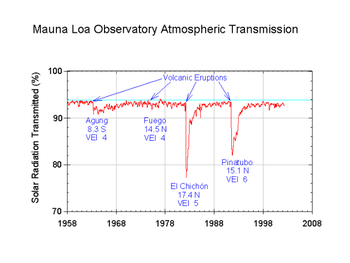

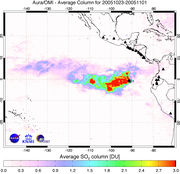
There are many different types of volcanic eruptions and associated activity: phreatic eruptions (steam-generated eruptions), explosive eruption of high-silica lava (e.g., rhyolite), effusive eruption of low-silica lava (e.g., basalt), pyroclastic flows, lahars (debris flow) and carbon dioxide emission. All of these activities can pose a hazard to humans. Earthquakes, hot springs, fumaroles, mud pots and geysers often accompany volcanic activity.
The concentrations of different volcanic gases can vary considerably from one volcano to the next. Water vapor is typically the most abundant volcanic gas, followed by carbon dioxide and sulfur dioxide. Other principal volcanic gases include hydrogen sulfide, hydrogen chloride, and hydrogen fluoride. A large number of minor and trace gases are also found in volcanic emissions, for example hydrogen, carbon monoxide, halocarbons, organic compounds, and volatile metal chlorides.
Large, explosive volcanic eruptions inject water vapor (H2O), carbon dioxide (CO2), sulfur dioxide (SO2), hydrogen chloride (HCl), hydrogen fluoride (HF) and ash (pulverized rock and pumice) into the stratosphere to heights of 16–32 kilometres (10–20 mi) above the Earth's surface. The most significant impacts from these injections come from the conversion of sulfur dioxide to sulfuric acid (H2SO4), which condenses rapidly in the stratosphere to form fine sulfate aerosols. The aerosols increase the Earth's albedo—its reflection of radiation from the Sun back into space - and thus cool the Earth's lower atmosphere or troposphere; however, they also absorb heat radiated up from the Earth, thereby warming the stratosphere. Several eruptions during the past century have caused a decline in the average temperature at the Earth's surface of up to half a degree (Fahrenheit scale) for periods of one to three years — sulfur dioxide from the eruption of Huaynaputina probably caused the Russian famine of 1601 - 1603.[11]
One proposed volcanic winter happened c. 70,000 years ago following the supereruption of Lake Toba on Sumatra island in Indonesia.[12] According to the Toba catastrophe theory to which some anthropologists and archeologists subscribe, it had global consequences,[13] killing most humans then alive and creating a population bottleneck that affected the genetic inheritance of all humans today.[14] The 1815 eruption of Mount Tambora created global climate anomalies that became known as the "Year Without a Summer" because of the effect on North American and European weather.[15] Agricultural crops failed and livestock died in much of the Northern Hemisphere, resulting in one of the worst famines of the 19th century.[16] The freezing winter of 1740-41, which led to widespread famine in northern Europe, may also owe its origins to a volcanic eruption.[17]
It has been suggested that volcanic activity caused or contributed to the End-Ordovician, Permian-Triassic, Late Devonian mass extinctions, and possibly others. The massive eruptive event which formed the Siberian Traps, one of the largest known volcanic events of the last 500 million years of Earth's geological history, continued for a million years and is considered to be the likely cause of the "Great Dying" about 250 million years ago,[18] which is estimated to have killed 90% of species existing at the time.[19]
The sulfate aerosols also promote complex chemical reactions on their surfaces that alter chlorine and nitrogen chemical species in the stratosphere. This effect, together with increased stratospheric chlorine levels from chlorofluorocarbon pollution, generates chlorine monoxide (ClO), which destroys ozone (O3). As the aerosols grow and coagulate, they settle down into the upper troposphere where they serve as nuclei for cirrus clouds and further modify the Earth's radiation balance. Most of the hydrogen chloride (HCl) and hydrogen fluoride (HF) are dissolved in water droplets in the eruption cloud and quickly fall to the ground as acid rain. The injected ash also falls rapidly from the stratosphere; most of it is removed within several days to a few weeks. Finally, explosive volcanic eruptions release the greenhouse gas carbon dioxide and thus provide a deep source of carbon for biogeochemical cycles.

Gas emissions from volcanoes are a natural contributor to acid rain. Volcanic activity releases about 130 to 230 teragrams (145 million to 255 million short tons) of carbon dioxide each year.[20] Volcanic eruptions may inject aerosols into the Earth's atmosphere. Large injections may cause visual effects such as unusually colorful sunsets and affect global climate mainly by cooling it. Volcanic eruptions also provide the benefit of adding nutrients to soil through the weathering process of volcanic rocks. These fertile soils assist the growth of plants and various crops. Volcanic eruptions can also create new islands, as the magma cools and solidifies upon contact with the water.
Ash thrown into the air by eruptions can present a hazard to aircraft, especially jet aircraft where the particles can be melted by the high operating temperature. Dangerous encounters in 1982 after the eruption of Galunggung in Indonesia, and 1989 after the eruption of Mount Redoubt in Alaska raised awareness of this phenomenon. Nine Volcanic Ash Advisory Centers were established by the International Civil Aviation Organization to monitor ash clouds and advise pilots accordingly. The 2010 eruptions of Eyjafjallajökull caused major disruptions to air travel in Europe.
Volcanoes on other planetary bodies

The Earth's Moon has no large volcanoes and no current volcanic activity, although recent evidence suggests it may still possess a partially molten core.[21] However, the Moon does have many volcanic features such as maria (the darker patches seen on the moon), rilles and domes.
The planet Venus has a surface that is 90% basalt, indicating that volcanism played a major role in shaping its surface. The planet may have had a major global resurfacing event about 500 million years ago,[22] from what scientists can tell from the density of impact craters on the surface. Lava flows are widespread and forms of volcanism not present on Earth occur as well. Changes in the planet's atmosphere and observations of lightning have been attributed to ongoing volcanic eruptions, although there is no confirmation of whether or not Venus is still volcanically active. However, radar sounding by the Magellan probe revealed evidence for comparatively recent volcanic activity at Venus's highest volcano Maat Mons, in the form of ash flows near the summit and on the northern flank.
There are several extinct volcanoes on Mars, four of which are vast shield volcanoes far bigger than any on Earth. They include Arsia Mons, Ascraeus Mons, Hecates Tholus, Olympus Mons, and Pavonis Mons. These volcanoes have been extinct for many millions of years,[23] but the European Mars Express spacecraft has found evidence that volcanic activity may have occurred on Mars in the recent past as well.[23]
Jupiter's moon Io is the most volcanically active object in the solar system because of tidal interaction with Jupiter. It is covered with volcanoes that erupt sulfur, sulfur dioxide and silicate rock, and as a result, Io is constantly being resurfaced. Its lavas are the hottest known anywhere in the solar system, with temperatures exceeding 1,800 K (1,500 °C). In February 2001, the largest recorded volcanic eruptions in the solar system occurred on Io.[24] Europa, the smallest of Jupiter's Galilean moons, also appears to have an active volcanic system, except that its volcanic activity is entirely in the form of water, which freezes into ice on the frigid surface. This process is known as cryovolcanism, and is apparently most common on the moons of the outer planets of the solar system.
In 1989 the Voyager 2 spacecraft observed cryovolcanoes (ice volcanoes) on Triton, a moon of Neptune, and in 2005 the Cassini-Huygens probe photographed fountains of frozen particles erupting from Enceladus, a moon of Saturn.[25] The ejecta may be composed of water, liquid nitrogen, dust, or methane compounds. Cassini-Huygens also found evidence of a methane-spewing cryovolcano on the Saturnian moon Titan, which is believed to be a significant source of the methane found in its atmosphere.[26] It is theorized that cryovolcanism may also be present on the Kuiper Belt Object Quaoar.
A 2010 study of the exoplanet COROT-7b, which was detected by transit in 2009, studied that tidal heating from the host star very close to the planet and neighboring planets could generate intense volcanic activity similar to Io.[27]
In culture
Past beliefs
Many ancient accounts ascribe volcanic eruptions to supernatural causes, such as the actions of gods or demigods. To the ancient Greeks, volcanoes' capricious power could only be explained as acts of the gods, while 16th/17th-century German astronomer Johannes Kepler believed they were ducts for the Earth's tears.[28] One early idea counter to this was proposed by Jesuit Athanasius Kircher (1602–1680), who witnessed eruptions of Mount Etna and Stromboli, then visited the crater of Vesuvius and published his view of an Earth with a central fire connected to numerous others caused by the burning of sulfur, bitumen and coal.
Various explanations were proposed for volcano behavior before the modern understanding of the Earth's mantle structure as a semisolid material was developed. For decades after awareness that compression and radioactive materials may be heat sources, their contributions were specifically discounted. Volcanic action was often attributed to chemical reactions and a thin layer of molten rock near the surface.
Panoramas




See also
- Volcanic ash
- Volcanic field
- Volcanic gas
- Geomorphology
- Earth science
- Shield volcano
- History of Volcanology
- Guyot
- Plinian eruption
- Prediction of volcanic activity
- Volcano observatory
- Volcano Number
- Tsunami
Lists
- List of volcanoes (terrestrial)
- List of extraterrestrial volcanoes
- List of famous volcanic eruption deaths
- Volcanic Explosivity Index (includes list of large eruptions)
- Timetable of major worldwide volcanic eruptions
- List of deadliest natural disasters
Specific locations
- Iceland hotspot
- Anahim hotspot
- Kerguelen hotspot
- East Australia hotspot
- Hawaii hotspot
- Bowie hotspot
- Réunion hotspot
- Galápagos hotspot
- New England hotspot
- Canary hotspot
- Pacific Ring of Fire
- Io (moon)
- Triton (moon)
People
- Category:Volcanologists
Further reading
- Marti, Joan and Ernst, Gerald. (2005). Volcanoes and the Environment. Cambridge University Press. ISBN 0-521-59254-2.
- Macdonald, Gordon A., and Agatin T. Abbott. (1970). Volcanoes in the Sea. University of Hawaii Press, Honolulu. 441 p.
- Ollier, Cliff. (1988). Volcanoes. Basil Blackwell, Oxford, UK, ISBN 0-631-15664-X (hardback), ISBN 0-631-15977-0 (paperback).
- Haraldur Sigurðsson, ed. (1999) Encyclopedia of Volcanoes. Academic Press. ISBN 0-12-643140-X. This is a reference aimed at geologists, but many articles are accessible to non-professionals.
- Cas, R.A.F. and J.V. Wright, 1987. Volcanic Successions. Unwin Hyman Inc. 528p. ISBN 0-04-552022-4
References
- ↑ Douglas Harper (November 2001). "Volcano". Online Etymology Dictionary. http://www.etymonline.com/index.php?term=volcano. Retrieved 2009-06-11.
- ↑ "Iceland". Jane Simmonds (1999). Langenscheidt. p.100. ISBN 0887291767
- ↑ "Volcano General Information"
- ↑ "Volcanoes". U.S. Department of the Interior, U.S. Geological Survey.
- ↑ "Mountains of fire: the nature of volcanoes". Robert Wayne Decker, Barbara Decker (1991). p.7. ISBN 0521312906
- ↑ "Volcanoes". European Space Agency.
- ↑ "Volcano Environments". U.S. Geological Survey.
- ↑ "Sensing Remote Volcanoes". NASA Earth Observatory.
- ↑ "Volcanoes". Reuters. December 12, 2009.
- ↑ Chesner, C.A.; Westgate, J.A.; Rose, W.I.; Drake, R.; Deino, A. (March 1991). "Eruptive History of Earth's Largest Quaternary caldera (Toba, Indonesia) Clarified". Geology 19: 200–203. http://www.geo.mtu.edu/~raman/papers/ChesnerGeology.pdf. Retrieved 2010-01-20.
- ↑ University of California - Davis (2008, April 25). "Volcanic Eruption Of 1600 Caused Global Disruption". ScienceDaily. http://www.sciencedaily.com/releases/2008/04/080423135236.htm.
- ↑ "Supervolcano Eruption -- In Sumatra -- Deforested India 73,000 Years Ago". ScienceDaily. November 24, 2009.
- ↑ "The new batch - 150,000 years ago". BBC - Science & Nature - The evolution of man.
- ↑ "When humans faced extinction". BBC. 2003-06-09. http://news.bbc.co.uk/2/hi/science/nature/2975862.stm. Retrieved 2007-01-05.
- ↑ "Volcanoes in human history: the far-reaching effects of major eruptions". Jelle Zeilinga de Boer, Donald Theodore Sanders (2002). Princeton University Press. p.155. ISBN 0691050813
- ↑ Oppenheimer, Clive (2003). "Climatic, environmental and human consequences of the largest known historic eruption: Tambora volcano (Indonesia) 1815". Progress in Physical Geography 27 (2): 230–259. doi:10.1191/0309133303pp379ra.
- ↑ "Ó Gráda, C.: Famine: A Short History". Princeton University Press.
- ↑ "Yellowstone's Super Sister". Discovery Channel.
- ↑ Benton M J (2005). When Life Nearly Died: The Greatest Mass Extinction of All Time. Thames & Hudson. ISBN 978-0500285732.
- ↑ "Volcanic Gases and Their Effects". U.S. Geological Survey. http://volcanoes.usgs.gov/Hazards/What/VolGas/volgas.html. Retrieved 2007-06-16.
- ↑ M. A. Wieczorek, B. L. Jolliff, A. Khan, M. E. Pritchard, B. P. Weiss, J. G. Williams, L. L. Hood, K. Righter, C. R. Neal, C. K. Shearer, I. S. McCallum, S. Tompkins, B. R. Hawke, C. Peterson, J, J. Gillis, B. Bussey (2006). "The Constitution and Structure of the Lunar Interior". Reviews in Mineralogy and Geochemistry 60 (1): 221–364. doi:10.2138/rmg.2006.60.3.
- ↑ D.L. Bindschadler (1995). "Magellan: A new view of Venus' geology and geophysics". American Geophysical Union. http://www.agu.org/journals/rg/rg9504S/95RG00281/index.html. Retrieved 2006-09-04.
- ↑ 23.0 23.1 "Glacial, volcanic and fluvial activity on Mars: latest images". European Space Agency. 2005-02-25. http://www.esa.int/esaMI/Mars_Express/SEMLF6D3M5E_0.html. Retrieved 2006-08-17.
- ↑ Exceptionally Bright Eruption on lo Rivals Largest in Solar System, Nov. 13, 2002
- ↑ PPARC, Cassini Finds an Atmosphere on Saturn's Moon Enceladus
- ↑ NewScientist, Hydrocarbon volcano discovered on Titan, June 8, 2005
- ↑ Jaggard, Victoria (2010-02-05). ""Super Earth" May Really Be New Planet Type: Super-Io". National Geographic web site daily news. National Geographic Society. http://news.nationalgeographic.com/news/2010/02/100205-new-type-planet-corot-7b-io/. Retrieved 2010-03-11.
- ↑ Micheal Williams (11-2007). "Hearts of fire". Morning Calm (Korean Air Lines Co., Ltd.) (11-2007): 6.
External links
- Volcanoes at the Open Directory Project
- Volcano Eruptions, Ancient & Modern slideshow by Life magazine
- Volcano, U.S. Federal Emergency Management Agency (FEMA)
- Volcano World

